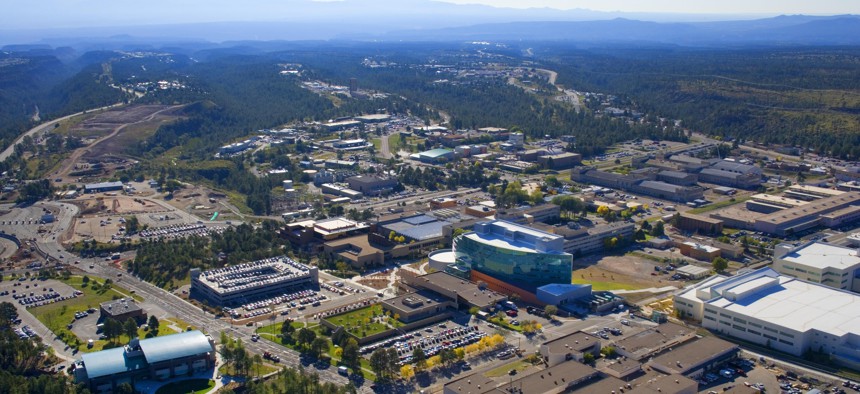
Los Alamos National Laboratory, September 18, 2006. Los Alamos National Laboratory
It Takes a Nuclear Weapons Lab to Find a Nuclear Weapons Lab
That’s why the US needs to continue to support cutting-edge science.
When North Korea tested its sixth nuclear weapon in September, instruments all over the world—and in orbit—were taking measurements to determine what kind of blast it was. How big? What materials were used?
Few people know that a whole branch of science is devoted to answering these questions—the science of nuclear nonproliferation—and its importance to both national and global security is critical. Simply put, nonproliferation science develops the technologies to help stop the spread of nuclear weapons, materials, and technologies. It encompasses an array of disciplines, including nuclear safeguards to verify that nuclear materials are secure and not diverted to a weapons program, and proliferation detection, such as nuclear explosion monitoring, which continuously scans the atmosphere and tracks seismologic events to make sure no one is testing nuclear weapons.
Nuclear nonproliferation efforts have contributed to slowing the spread of nuclear weapons around the world. But it’s not easy—as the recent tests by North Korea remind us—and will continue to require a global commitment and cutting-edge science to ensure its success.
Why nuclear?
Nuclear materials are used for a variety of peaceful purposes—such as detecting and treating cancer, killing bacteria in food, and, most notably, energy production. The global use of nuclear energy is growing—and for good reason. It’s clean, inexpensive, and efficient. But the downside of nuclear energy is that most reactors require enriched uranium to operate—and highly enriched uranium can also be used to develop nuclear weapons. In addition, used or “spent” nuclear fuel from reactors contains plutonium, another weapons-usable nuclear material. There are countries that have nuclear power but no existing nuclear weapons program, such as Japan and Germany, who, along with 180 other countries, signed the Nuclear Nonproliferation Treaty and agreed not to pursue a nuclear weapons program. The global community’s goal is to support the peaceful use of nuclear power while limiting the spread of nuclear weapons.
The idea of safeguarding nuclear materials began in 1957, when the International Atomic Energy Agency (IAEA) was established following President Eisenhower’s “Atoms for Peace” speech at the United Nations to promote the peaceful use of nuclear technology. The United States’ involvement began in earnest 10 years later, when Los Alamos National Laboratory spearheaded the development of instruments to measure nuclear material. Los Alamos, where the first atomic bomb was developed, was a likely candidate for this kind of work due to the needs of Los Alamos for better material control and accounting for its own nuclear material. More generally, figuring out whether a nation is developing the capacity to build nuclear weapons requires knowing what a nuclear weapons program looks like, what materials it requires, what processing must happen, etc. In other words, it takes a nuclear weapons lab to find a nuclear weapons lab.
Consequently, our scientists pioneered a wide range of IAEA measurement tools still in use today, including non-destructive assay instrumentation for quantifying nuclear material inventories and gamma and neutron detectors. These instruments work passively, measuring the emitted radiation, and don’t require destructive sampling of the materials being measured.
Last year, we helped establish the China Center of Excellence on Nuclear Security, a forum for exchanging technical information, by developing training courses and promoting technical collaborations that will enhance nuclear security in China and throughout Asia. This is crucial, particularly given that, by 2026, China will almost triple its nuclear capacity, making it the biggest nuclear power market in the world.
Beyond safeguarding nuclear material, a key component of nonproliferation science is detecting illicit nuclear activity. As we see in North Korea, the threat of a rogue nation with nuclear weapons is real. But what weapons are they developing? Pyongyang is not sharing the details. That’s why we have instruments on satellites orbiting the Earth that detect x-rays, gamma rays, and neutrons—all signatures of a nuclear explosion—as well as the natural background of radiation in space. (These radiation detectors are also used to help protect satellites from space weather events that can result in catastrophic failures.)
Furthermore, we’ve developed sensors that are used around the world to detect seismological events that could indicate a nuclear test. When the ground shakes, it can be the result of any number of events—from an earthquake to a mining operation to a nuclear weapons test. It’s crucial to understand the difference. After all, no one wants to initiate a global response over a misinterpreted seismic event.
Earlier detection
Like all scientific pursuits, continuous exploration and improvement are key. We need to understand—and block—the pathways to nuclear weapons development through enhanced safeguard technologies and earlier detection—before an underground test.
A recent series of high-explosives experiments is helping researchers do this. Los Alamos, in partnership with four other national security labs, took measurements from optical and radio-frequency signals from these experiments in the Nevada desert as part of the National Nuclear Security Administration’s HELIOS project. These signals mimic those that would be present in a nascent nuclear weapons development program. The goal is to develop a detection system that would be able to identify a nuclear weapons program in its earliest stages.
As more countries look to nuclear means to address their energy challenges, and as countries like North Korea are emboldened to test nuclear weapons despite international pressure, the need to be able to detect and characterize those tests to help policymakers make appropriate decisions becomes increasingly important. For these reasons, the role of nonproliferation science will continue to grow as a way of making the world a safer place. We must be ready to answer the call.
NEXT STORY: Don’t Kill the Nuclear Cruise Missile



